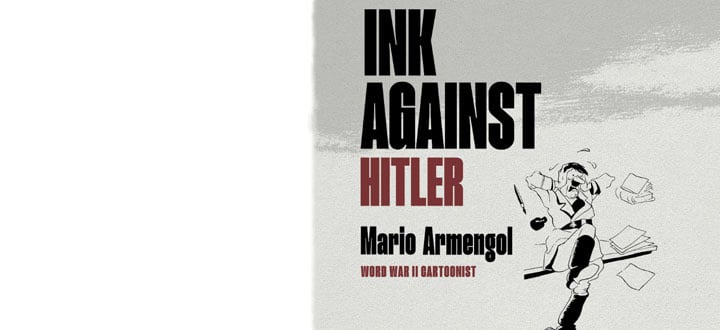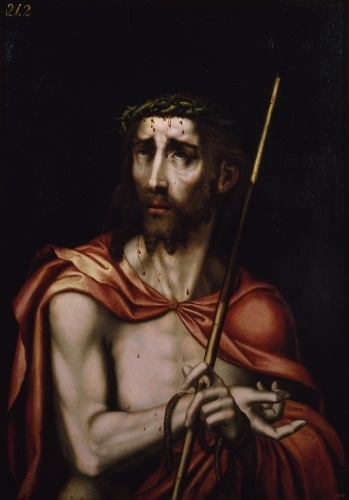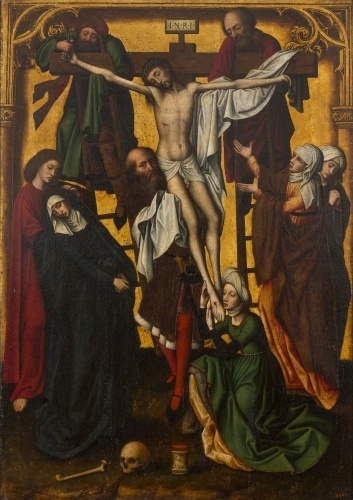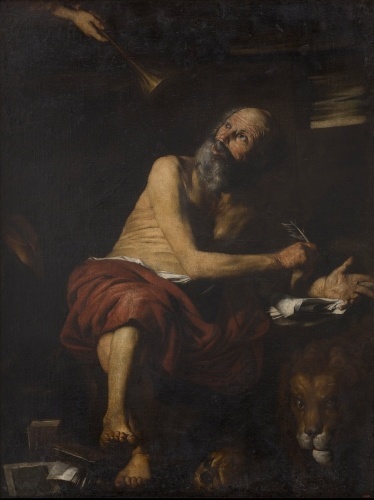Art and devotion

The Mother of God, one of the paradigm emblems of the militantly doctrinaire spirit of the Catholic Church in the wake of the Council of Trent, assumed great importance in the religious art of the period. The fervent promulgation of the dogma of the Immaculate Conception reveals the commitment of the Catholic hierarchy to asserting the intercessionary role allotted to Mary. The iconographic repertoire contains a large number of variants. One of these is the Sagrada Conversazione, the Sacred Conversation, in which the Mother of God occupies the central space, surrounded by saints who engage in a visual dialogue with her and bear witness to the revealed truth. There are other compositions, more conventional and austere, which centre on the Mother and Son, and, far from the hieratic attitude of earlier periods, these seek to emphasize Mary’s condition as a mother and the affective bond she forges with the infant Jesus.
Sacra conversazione
The Enthroned Virgin, or Sedes Sapientiae, symbolizes the Church’s universal power and wisdom. This idea is reinforced with the presence of Saint Peter with the keys to Paradise and the Gospel, and Saint Paul with the sword of martyrdom: the former as the institution’s founder and the latter as its guarantor. The iconography reproduces the model of the sacred conversations between the Apostles and the Virgin. The compositional scheme of this panel by Vincenzo Frediani (Lucca, recorded 1476 – died 1505) refers to the scene that the Florentine painter Domenico Ghirlandaio (1448/49 – 1494) had painted in the Cathedral of Saint Martin, and shows the expansion of the Florentine style beyond the city of the Medici family.
|
Peter Paulus Rubens, Virgin and Child with Saint Elizabeth and the Young Saint John, circa 1618 |
Vincenzo Frediani, Virgin and Child between Saint Peter and Saint Paul, circa 1490 |
Few symbols have achieved the universal iconic dimension of the cross. Regarded as the supreme emblem of the Christian community, the cross is a primary referent in its devotional iconography and a passionate symbol of sacrifice. Thanks in large measure to its capacity to transcend and attract, the cross is one of the motifs most frequently used by the artists of the period, and one that has endured beyond the historical and cultural context in which it emerged and was developed. In keeping with the example of the Martyrdom and Passion of Christ, Baroque iconography transforms the depiction of scenes of martyrdom – in which the protagonists are subjected to the most terrible tortures and the most unimaginable suffering – into images of worship and devotion in which the faithful see themselves reflected in these virtuous models, and imitate and establish empathic relationships with them.
|
Luis de Morales (El Divino), Ecce Homo, between 1570-1580 |
Marcellus Coffermans, Descent from the Cross, Third quarter of the16th century |
The Counter-Reformation elevated the figure of the saint to the status of an important mediator between man and God. The saint’s example, of meditation, prayer and renunciation of material things and the ideal of the contemplative life were to encourage the faithful to intensify their experience of Christian faith and facilitate communion with the divine. Rapture or mystical ecstasy, visionary illumination of a prophetic nature and an attitude of abnegation and unconditional dedication to the faith are among the external signs of the ideal of the Christian life, and many seventeenth-century paintings set out to exalt the kinds of supernatural experiences that inspire a state of religious plenitude in the subject. Far from provoking incredulity, this type of experience awakens in the believer an emotional response, a pious agitation of the mind and senses.
|
Doménikos Theotokópoulos (El Greco), Saint Peter and Saint Pau, 1590-1600 |
Josep de Ribera, Saint Jerome, 1618-1625 |
In Christian culture, the principle of decorum obliged believers to clearly distinguish between sacred and mundane or secular spaces, in accordance with a principle of hierarchical separation. However, in some depictions of saints, the verisimilitude of the account required that elements from both spheres should appear in the same space.
With the use of striking mise-en-scène effects derived from the theatre, Baroque iconography depicted episodes from the lives of the saints in a geographical imaginary shared by earthly and heavenly beings, a hybrid or composite of the two realities. This geography became a metaphor for the power of intercession of sacred images as objects of veneration, as well as being a clear allusion to the higher faculties attributed to saints.
Pictorial cycles
Painted religious series or cycles developed iconographical programmes based on hagiographical episodes. The figures most commonly used were the monastic orders. The appearance of this artistic type, indebted largely to devotional narrative forms, is framed in the context of the spread of a new Catholic culture that regarded the use of images for doctrinal purposes very positively. Following the precepts of the Counter-Reformation, commissioners sought more familiar realistic models that would help to spread the faith, and they used both literary and engraved sources, which artists often imitated.
|
Paolo De Matteis, King Wenceslaus IV Sentences Saint John of Nepomuk, 1710 |
Andrea Vaccaro, The Healing of Tobit, 1667 |












